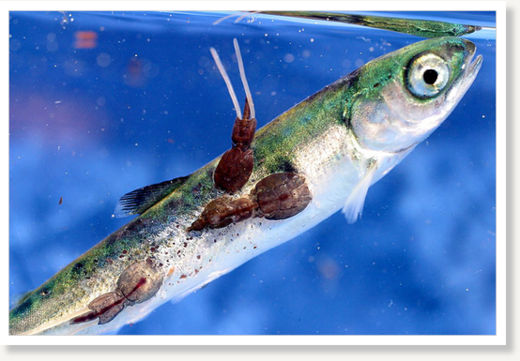
© Unknown
Last month, 138,000 farmed salmon escaped from feedlots on the New Brunswick side of the Bay of Fundy, a fact that scarcely caused a ripple in the Maritime consciousness. Elsewhere - in Norway, Scotland, Chile, British Columbia - salmon farming is a highly controversial industry. Here it seems to skate along smoothly under the radar.
Salmon farming is controversial for two main reasons. First, it is a highly inefficient way to produce food. Producing feed for farmed salmon intensifies the pressure on other fisheries around the world. In effect, the process turns four kilograms of wild fish into one kilogram of industrial fish. How clever is that?
Second, salmon farms have horrible effects on the marine environment and on wild salmon. A salmon cage consists of an outer layer of netting to keep predators out, and an inner layer to keep salmon in. But parasites, bacteria, viruses and chemicals can move freely in and out of the cages - and, like all intensive industrial food production facilities, the salmon cage holds the maximum number of animals packed in together.
The clustered fish are succulent targets for epidemics of parasites such as sea lice, which can move easily through the mesh cages, and viruses such as infectious salmon anemia, which first appeared in Norway in the 1980s, and now inhabits salmon farms in Scotland, Chile and New Brunswick.
To combat disease, discourage parasites and maximize growth, farmed salmon are dosed regularly with hormones, pesticides and antibiotics, which create ever-more resistant pests - and, in New Brunswick, a great many dead lobsters.
The salmon are also exuberant producers of feces.
Their cages are the pigpens of the ocean. The sea floor near a salmon cage is a dead zone paved with foul food and fish doo, all bathed in a soup of bio-chemicals.
The other critter that can move through the netting of a salmon cage is a salmon, at least when the netting is torn or the cage is wrecked by storms, as happened in the Bay of Fundy last month.
Once released, the farmed salmon - invariably the Atlantic variety - are free to pollute the very genetic code of indigenous wild salmon.
In B.C., interbreeding poses less of a threat than it does here in the Atlantic, where the wild fish and the farmed ones are the same species - though the farmed fish are very different from the wild ones.
Nature cannot cull the caged fish by way of predation, disease or parasites, so weak escapees survive to pass on their weaknesses in the wild. In addition, a farmed fish lacks a wild fish's genetic information - like the knowledge of its home stream, which is also its spawning ground. Will the hybrid offspring even know how to reproduce? Norwegian research indicates that escaped salmon and their young compete fiercely for mates and habitat, but when the young go to sea, they don't return.
The dominant players in salmon farming worldwide are Norwegian companies, who developed the net-pen salmon industry. But in Norway today, reports Alexandra Morton, the B.C. warrior-scientist who has devoted her life to the protection of wild salmon, "nine out of 10 salmon rivers in the heavily farmed Hardanger Fjord have collapsed," while fish farmers "are now pumping farm salmon into well boats and bathing them in hydrogen peroxide trying to kill the lice" - a technique also used in New Brunswick.
Norway's former attorney general, who oversaw the original Norwegian aquaculture plan, now calls salmon farming "a heavy defeat for wild salmon and a huge win for sea lice." And the Norwegian Institute of Marine Science, long a supporter of fish farming, now suggests that the risks to wild salmon mean that cage-net farming conflicts with Norway's sustainability strategy.
In Scotland, the Atlantic Salmon Trust, headed by the Prince of Wales, recently blasted the Scottish government for allowing fish farms to endanger Scotland's wild salmon. In B.C., Alexandra Morton and others want all salmon farms moved to above-ground tanks completely isolated from wild fish. Here in the Maritimes, where salmon stocks are officially designated as endangered, the Atlantic Salmon Federation is also demanding above-ground tanks.
Meanwhile, in Nova Scotia, a New Brunswick company proposes to rear a million net-caged salmon in St. Mary's Bay. At this stage, how long should it take to say No?
Reader Comments
to our Newsletter